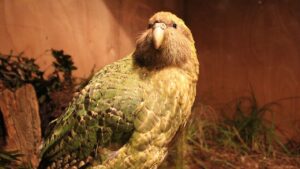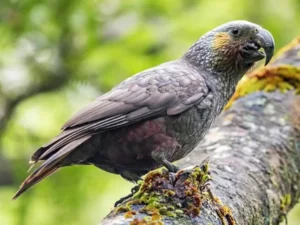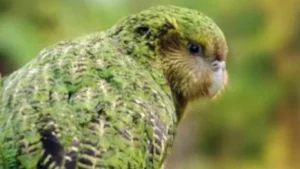The Kakapo Parrot: A Flightless Marvel of New Zealand
Introduction
The kakapo Strops habroptilus, generally called the owl parrot, is a momentous and intriguing bird nearby to New Zealand. With its indisputable characteristics and essentially jeopardized status, the has transformed into a picture of insurance attempts and normal importance. This article dives into the ‘s superb traits, its unquestionable hardships, and ceaseless conservation attempts .

Physical Characteristics
The kakapo is an exceptional parrot with a blend of features that set it beside other bird species. Rather than most parrots, the is flightless, which is astonishing for its friends and family. It has a strong, owl-like appearance, with a round face, tremendous yellowish-green plumes, and an unquestionable facial circle that updates its evening time vision. This hint helps it with blending into its forest area environment, giving cover from trackers.
The kakapo is also conspicuous for its size, being one of the heaviest parrot species on earth. Folks can check as much as 4 kilograms (around 8.8 pounds), making them extremely immense diverged from various parrots. Regardless of their weight, are capable climbers, using serious solid areas for themselves and sharp snares to investigate through trees and thick underbrush.
Behavior and Diet
Kakapos are evening time and basically herbivorous. They feed on a variety of plant materials, including leaves, natural items, seeds, and blooms. Their eating routine is urgent for their perseverance, as they rely upon unambiguous plant species to stay aware of their prosperity and conceptive accomplishment. The dealing with penchants can through and through influence the organic frameworks they have, as their use of explicit plants helps in seed dispersal.
Socially, are to some degree single, with each bird spreading out and staying aware of its locale. Folks are known for their remarkable duplicating call, which is a disperse and significant thundering sound used to attract females during the mating season. This bring can expand critical distances, crucial for attracting mates in thick woods conditions.
Conservation Status
The kakapo’s lightlessness and restricted dissemination made it exceptionally defenseless against predation, especially with the presentation of non-local species like rodents, stoats, and felines to New Zealand. These hunters, alongside natural surroundings obliteration, prompted an emotional decrease in populaces.
By the late twentieth hundred years, the kakapo was near the precarious edge of annihilation, with around 50 people remaining. Preservation endeavors were sent off, including environment insurance, hunter control, and a weighty reproducing program. One of the most eminent drives is the Recuperation Program, which centers around expanding the populace through concentrated administration and observing.
Current Conservation Efforts
Today, the populace has expanded to north of 200 people, on account of committed progressives and researchers. The Recuperation Program keeps on utilizing different methodologies to help the species, including:
Predator-Free Islands
The kakapo is presently restricted to a few hunter free islands where they are protected from presented dangers. These islands give a safe-haven where can reside and raise without the gamble of predation.
Genetic Management:
To keep away from inbreeding and keep up with hereditary variety, the recuperation program cautiously oversees rearing matches and screens the hereditary wellbeing of the populace.
Artificial Nesting and Hand-Rearing:
: Protectionists utilize counterfeit settling destinations and hand-raising strategies to help the rearing system and increment the endurance pace of chicks
Monitoring and Research:
Progressing exploration and checking assist with following the wellbeing, conduct, and conceptive outcome of the kakapo, giving significant information to future protection endeavors.

Future Outlook
Because of these purposeful endeavors, the populace has given promising indications of recuperation, with numbers surpassing 200 people. Be that as it may, the species remains fundamentally jeopardized and needs continuous help and cautiousness. Protectionists keep on confronting difficulties, for example, environmental change, natural surroundings the board, and guaranteeing the drawn out supportability of the kakapo populace.
The fills in as a strong image of both the delicacy and flexibility of the normal world. Its recuperation features the significance of committed preservation endeavors and the significant effect that human mediation can have on safeguarding jeopardized species.
Physical Characteristics
The kakapo is perhaps of the biggest parrot on the planet, with guys gauging as much as 4 kilograms (8.8 pounds) and estimating around 60 centimeters (24 inches) long. Its appearance is set apart by a strikingly owl-like face, which is improved by a facial plate of plumes that guides in its nighttime way of life. The kakapo’s plumage is a blend of green, yellow, and brown with spotted designs, giving phenomenal disguise in its timberland living space.
Flightlessness
The kakapo’s flightlessness is a remarkable transformation. Not at all like different parrots that have developed to fly, the kakapo has areas of strength for created and a powerful body that guide in climbing and moving through thick vegetation. Its enormous pectoral muscles, while advanced for climbing, are not adjusted for flight. The deficiency of flight is an immediate consequence of its development in a climate without mammalian hunters, prompting a diminished requirement for the capacity to get away from by flying.
Behavior and Diet
Kakapos are basically nighttime, meaning they are dynamic during the evening and rest during the day. Their sharp feeling of smell and huge eyes are adjusted to their low-light climate. They utilize major areas of strength for them to scavenge for an assortment of plant materials, including leaves, organic products, seeds, and blossoms. Their eating regimen is wealthy in supplements and is fundamental for their general wellbeing and conceptive achievement.
Foraging and Ecological Impact
The kakapo’s scavenging conduct essentially influences its biological system. By consuming and scattering seeds from different plants, the kakapo assumes a urgent part in keeping up with the wellbeing and variety of New Zealand’s woods. Their taking care of propensities can impact plant populace elements and add to woods recovery.
Reproductive Behavior
The kakapo’s regenerative framework is quite possibly of its most intriguing perspective. They display a lekking mating framework, where guys assemble in a particular region and contend to draw in females. During the reproducing season, guys play out an unmistakable flourishing call, which can be heard over significant distances. This call isn’t just a method for drawing in females yet in addition fills in for the purpose of laying out predominance among guys.
Breeding Challenges
Rearing is a basic and testing part of kakapo preservation. The species has a low regenerative rate, part of the way because of its long rearing cycle and the high speculation of assets in each egg. Females lay eggs each 2-4 years, and each home regularly contains 1-4 eggs. The fruitful raising of chicks is impacted by elements like food accessibility and ecological circumstances.
Historical Challenges
The kakapo’s set of experiences has been set apart by critical difficulties, principally because of the presentation of hunters and living space misfortune. Before human appearance, New Zealand’s biological system was somewhat steady, with the kakapo developing in a climate absent any and all mammalian hunters. This permitted the kakapo to adjust to a flightless way of life, however it likewise made them defenseless when hunters like rodents, stoats, and felines were presented

Population Decline
By the late twentieth 100 years, the kakapo populace had dwindled to a basic point. Living space obliteration, joined with predation on eggs and chicks, prompted an extreme decrease in numbers. The populace was decreased to less than 50 people, making the kakapo perhaps of the most extraordinary bird on the planet.
Conservation Efforts
The Kakapo Recuperation Program addresses an exceptional illustration of animal categories protection. Started during the 1990s, this program utilizes a complex way to deal with guarantee the endurance of the kakapo.
Predator-Free Sanctuaries
To safeguard the kakapo from presented hunters, a few hunter free islands have been laid out as safe-havens. These islands, like Codfish Island and Little Hindrance Island, give a protected climate where kakapos can reside and raise without the danger of predation. The administration of these safe-havens includes thorough control measures to keep up with hunter free circumstances.
Genetic Management
Keeping up with hereditary variety is vital for the drawn out wellbeing of the kakapo populace. The Kakapo Recuperation Program incorporates an itemized hereditary administration intend to forestall inbreeding and guarantee a sound genetic stock. This includes checking hereditary lines and coming to vital conclusions about rearing matches to expand hereditary variety.
Artificial Nesting and Hand-Rearing
Notwithstanding regular settling locales, counterfeit settling boxes have been acquainted with help the kakapo’s rearing interaction. A few eggs and chicks are hand-raised to build their possibilities of endurance and guarantee effective reconciliation into the populace. This active methodology has demonstrated viable in supporting chick endurance rate
Monitoring and Research
Progressing checking and research are fundamental for figuring out the kakapo’s wellbeing, conduct, and conceptive achievement. Protectionists utilize progressed following innovation and information assortment strategies to assemble important data. This examination illuminates protection techniques and helps address arising difficulties.
Public Engagement and Education
Future Outlook

The kakapo populace has given promising indications of recuperation, with numbers presently surpassing 200 people. Notwithstanding, the species remains fundamentally jeopardized, and continuous protection endeavors are fundamental to guarantee its drawn out endurance. Difficulties, for example, environmental change, territory the board, and keeping up with hereditary variety keep on requiring consideration.
The account of the kakapo is one of strength and trust. Its recuperation features the significance of committed protection endeavors and fills in as a demonstration of the positive effect that human mediation can have on safeguarding jeopardized species.
Cultural Significance
The kakapo holds a unique spot in New Zealand’s social legacy. It is one of the country’s most notable local species and elements conspicuously in Māori folklore and custom. In Māori culture, the kakapo is known as “kākāpō” and is loved for its one of a kind qualities and its job in the regular world. The bird’s unique case and the work to save it resound profoundly with neighborhood networks and have turned into an image of New Zealand’s obligation to protecting its regular legacy.
Indigenous Knowledge and Conservation
Māori conventional information and practices play had a vital impact in the protection of New Zealand’s widely varied vegetation. The reconciliation of Māori viewpoints and values into present day preservation endeavors has advanced the way to deal with safeguarding species like the kakapo. By joining native information with logical exploration, protectionists have fostered a more comprehensive comprehension of the kakapo’s requirements and the difficulties it faces.
The Role of Technology in Conservation
Mechanical progressions have been instrumental in the kakapo recuperation endeavors. Developments, for example, GPS following, computerized checking frameworks, and hereditary examination instruments have upgraded the capacity of researchers and progressives to oversee and safeguard the kakapo populace really.
GPS Tracking
GPS beacons have been utilized to screen the developments and ways of behaving of kakapos in nature. This innovation gives important information on their reach, territory use, and collaborations. By following individual kakapos, analysts can all the more likely figure out their biological necessities and adjust preservation procedures appropriately.
Automated Monitoring Systems
frameworks, including movement sensor cameras and acoustic checking gadgets, have been conveyed to notice kakapo action and recognize any progressions in their way of behaving. These frameworks consider nonstop checking without upsetting the birds, giving experiences into their wellbeing, settling examples, and social connections.
Genetic Analysis
High level hereditary investigation strategies are utilized to concentrate on the hereditary variety of the kakapo populace. By breaking down DNA tests, researchers can evaluate hereditary wellbeing, distinguish potential issues connected with inbreeding, and settle on informed conclusions about reproducing matches. This data is pivotal for keeping a strong and different populace.
Collaborative Efforts
The recuperation of the kakapo isn’t exclusively the aftereffect of endeavors by progressives and researchers. It includes coordinated effort with different partners, including government offices, non-legislative associations, neighborhood networks, and global accomplices. This cooperative methodology has been fundamental in assembling assets, sharing information, and executing viable preservation measures.
Government and NGO Involvement
The New Zealand government, through organizations like the Division of Preservation (DOC), has been a vital participant in the kakapo recuperation program. DOC gives financing, assets, and backing for protection drives. Moreover, non-legislative associations (NGOs) and preservation bunches contribute aptitude, volunteer help, and backing to additional the recuperation endeavors.
International Collaboration
The kakapo recuperation program has additionally profited from global joint effort. Protectionists from around the world have shared their mastery and assets to help the venture. This worldwide organization of help features the widespread obligation to protecting imperiled species and the significance of global collaboration in preservation endeavors.
Lessons Learned and Future Prospects
The kakapo recuperation exertion offers important examples for traditionalists working with other jeopardized species. The experience acquired from dealing with the perplexing requirements and defeating difficulties gives bits of knowledge into powerful preservation methodologies, including living space the executives, hunter control, and local area commitment.
Adapting to Climate Change
As environmental change keeps on affecting biological systems around the world, the kakapo recuperation program should adjust to new difficulties. Changes in temperature, precipitation examples, and vegetation might influence the kakapo’s living space and food sources. Specialists and preservationists are investigating ways of moderating these effects and guarantee the drawn out strength of the kakapo populace.
Expanding Conservation Efforts
While the attention has been on the kakapo, the more extensive protection local area is additionally tending to the safeguarding of New Zealand’s interesting biological systems and other imperiled species. The examples gained from the kakapo recuperation program are being applied to comparable undertakings, adding to a more far reaching way to deal with preservation.
Ecosystem Dynamics
Kakapos add to their biological system in more than one way. As seed dispersers, they assist with keeping up with plant variety by consuming foods grown from the ground seeds across their natural surroundings. This cycle helps with the recovery of local woods, which thusly upholds many different species. The deficiency of kakapos could have flowing impacts on the timberland biological system, possibly upsetting plant and creature associations and diminishing biodiversity.
Outreach Programs
Instructive effort programs are intended to illuminate people in general about the kakapo’s predicament and the significance of protection. Schools, local gatherings, and media crusades are utilized to spread mindfulness and motivate activity. By drawing in with individuals of any age, these projects assist with building a learned and strong local area.
Volunteer Opportunities
Volunteer projects give amazing open doors to people to take part in protection endeavors effectively. Volunteers might help with errands, for example, checking kakapo populaces, assisting with territory rebuilding, and partaking in state funded training exercises. These projects support the recuperation endeavors as well as encourage a feeling of unique interaction to the protection work.
Conclusion
The kakapo parrot’s excursion from close to elimination to recuperation is a demonstration of the force of devoted protection endeavors and the potential for positive change. Through creative techniques, mechanical headways, and cooperative endeavors, the kakapo’s story offers expectation and motivation for the conservation of our planet’s extraordinary biodiversity.

